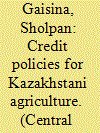| Srl | Item |
| 1 |
ID:
133884


|
|
|
|
|
| Publication |
2014.
|
| Summary/Abstract |
It is well known that around 80 per cent of farmers in India are in the small or marginal farmers group which requires financial resources on a regular basis for their farming activities. Needless to say, as these households do not possess adequate savings, accessibility to financial resources at reasonable terms and conditions from financial intermediaries becomes a crucial parameter for their productive activities and hence, in turn, their well-being. Based on the 59th round of household-level data from the Debt and Investment Survey and the Situation Assessment Survey (SAS) of farmers provided by the National Sample Survey Organisation (NSSO) of India, this article examines the nature of exclusion faced by farmer households in credit markets across selected prominent states of India. This is done by constructing an indicator, namely, the 'incidence of borrowing'. This article also tries to identify the factors that explain exclusion from access to financial resources by developing a methodology for the detection of credit exclusion. Our results show that the relation between the cost of credit (interest rate) and access to credit depends heavily on the extent of prevalence of informal lenders in a region.
|
|
|
|
|
|
|
|
|
|
|
|
|
|
|
|
| 2 |
ID:
106449


|
|
|
|
|
| Publication |
2011.
|
| Summary/Abstract |
This paper reviews the characteristics of the agricultural credit policy in Kazakhstan with a particular focus on emerging rural financial institutions. It is not easy to evaluate the real effect of credit policies due to the limited funds directed at agricultural production. Kazakhstani experience shows that commercial banks are used almost exclusively to provide agricultural producers with credit, while the new specialized credit institutions emerging in the agricultural sector only cater to a very small fraction of the total demand for credit. Presently, there are discussions in Kazakhstan concerning the creation of a specialized agricultural bank; however, this idea has some shortcomings that should be taken into consideration. Lack of credit is one of the main reasons for insufficient investment in agriculture. The underdeveloped land market in Kazakhstan makes formal credit institutions very cautious about accepting agricultural land as collateral.
|
|
|
|
|
|
|
|
|
|
|
|
|
|
|
|
| 3 |
ID:
168335


|
|
|
|
|
| Summary/Abstract |
This article investigates the influences of credit policy and financial constraints on tangible and research & development (R&D) investments from China's firm-level renewable energy industry using dynamic panel generalized moments of method (GMM) analysis. China's renewable energy industry has exuberant tangible investments, and its annual R&D investments are increasing. The empirical results demonstrate that firm-specific features, credit policy and financial constraints have significant impacts on the tangible and R&D investments in the renewable energy industry. Greater commercial bank credits, richer liquid assets, higher returns on assets and better investment opportunities may promote renewable energy firms' tangible investments, while more long-run debts and higher bank dependence may reduce their tangible investments. Larger firm sizes, more short-run debts, higher liability leverages, richer liquid assets and greater bank dependence may increase renewable energy firms' R&D investments, while more long-run debt and greater commercial bank credits may decrease their R&D investments according to the results of the study.
|
|
|
|
|
|
|
|
|
|
|
|
|
|
|
|